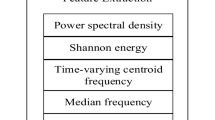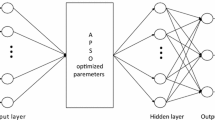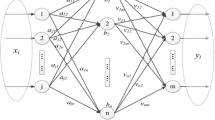Abstract
Birth weight is considered a major factor when monitoring any signs of abnormalities in the growth of the fetus and taking timely decisions related to labor management. Existing methods involve specialized equipment and training, which makes them less feasible for underdeveloped areas. Therefore, this study proposed a system for prediction of childbirth weight through kernel extreme reservoir machines and optimized the model parameters by the use of particle swarm optimization. Experimental results showed a significant improvement in the recommended method over existing models. The proposed approach is more economical than the traditional ultrasound making it extremely suited to underprivileged communities.











Similar content being viewed by others
References
Anggraini D, Abdollahian M, Marion K. Foetal weight prediction models at a given gestational age in the absence of ultrasound facilities: application in Indonesia. BMC Pregnancy Childb. 2018;18(1):436.
Deb K. An introduction to genetic algorithms. Sadhana. 1999;24:293–315. https://doi.org/10.1007/BF02823145.
Bajracharya J, Shrestha NS, Karki C. Accuracy of prediction of birth weight by fetal ultrasound. Kathmandu Univ Med J. 2012;10(2):74–6.
Grantham-McGregor S, Cheung YB, Cueto S, Glewwe P, Richter L, Strupp B. International Child Development Steering Group. Developmental potential in the first 5 years for children in developing countries. Lancet. 2007;369(9555):60–70. https://doi.org/10.1016/S0140-6736(07)60032-4.
Njoku C. Determination of accuracy of fetal weight using ultrasound and clinical fetal weight estimations in Calabar South. International scholarly research notices: South Nigeria; 2014.
Kehinde OA, Njokanma OF, Olanrewaju DM. Parental socioeconomic status and birth weight distribution of Nigerian term newborn babies. Niger. J. Paediatr. 2013;40(3):299–302.
Kaya Y. Evaluation of texture features for automatic detecting butterfly species using extreme learning machine. J. Exp. Theor. Artif. Intell. 2014;26(2):267–81.
Huang GB, Zhu QY, Siew CK. Extreme learning machine: theory and applications. Neurocomputing. 2006;70(1–3):489–501.
Matias T. Learning of a single-hidden layer feedforward neural network using an optimized extreme learning machine. Neurocomputing. 2014;129:428–36.
Lu S. A pathological brain detection system based on extreme learning machine optimized by bat algorithm. CNS Neurol Disord Drug Targets. 2017;16:23–9.
Suresh S, Saraswathi S, Sundararajan N. Performance enhancement of extreme learning machine for multi-category sparse data classification problems. Eng Appl Artif Intell. 2010;23(7):1149–57.
Eberhart R, Kennedy J. A new optimizer using particle swarm theory. In: MHS’95. Proceedings of the Sixth International Symposium on Micro Machine and Human Science; 1995. pp. 39–43. https://doi.org/10.1109/MHS.1995.494215.
Xu Y, Shu Y. Evolutionary Extreme Learning Machine—based on Particle Swarm Optimization. In: Wang J, Yi Z, Zurada JM, Lu BL, Yin H, editors. Advances in Neural Networks—ISNN 2006. Berlin, Heidelberg: Springer; 2006. p. 644–52.
Han F, Yao HF, Ling QH. An improved evolutionary extreme learning machine based on particle swarm optimization. Neurocomputing. 2013;116:87–93.
Vidhya S, Kamaraj V. Particle swarm optimized extreme learning machine for feature classification in power quality data mining. Automatika. 2017;58(4):487–94. https://doi.org/10.1080/00051144.2018.1476085.
Velló MA, Martínez-Costa C, Catalá M, Fons J, Brines J, Guijarro-Martínez R. Prenatal and neonatal risk factors for the development of enamel defects in low birth weight children. Oral Dis. 2010;16(3):257–62. https://doi.org/10.1111/j.1601-0825.2009.01629.x. Erratum in: Oral Dis. 2011;17(1):128.
Dare FO. The value of symphysio-fundal height/abdominal girth measurements in predicting fetal weight. Int J Gynecol Obstet. 1990;31(3):243–8.
Shittu AS, Kuti O, Orji EO, Makinde NO, Ogunniy SO, Ayoola OO, Sule SS. Clinical versus sonographic estimation of foetal weight in southwest Nigeria. J Health Popul Nutr. 2007;25(1):14–23.
Nahum GG. Detecting and managing fetal macrosomia. Contemp OB/Gyn. 2000a;45(6):89.
Nahum GG. Fetal macrosomia: detection, risks, and management. Postgrad Obstet Gynecol. 2000b;20(10):1–8.
Chauhan SP. Intrapartum clinical, sonographic, and parous patients’ estimates of newborn birth weight. Obstet Gynecol. 1992;79(6):956–8.
Nzeh DA. Prediction of birthweight by fetal ultrasound biometry. 1992.
Etikan I, Çaglar MK. Prediction methods for babies’ birth weight using linear and nonlinear regression analysis. 2005.
Nahum GG, Stanislaw H, Huffaker BJ. Accurate prediction of term birth weight from prospectively measurable maternal characteristics. J Reprod Med. 1999;44:705–12.
Ojwang S, Ouko BC. Prediction of fetal weight in utero by fundal height/girth measurements. J Obstet Gynecol East Central Afr. 1984;3:111.
Shittu A, Kuti O, Orji E, Makinde N, Ogunniy S, Ayoola O, Sule S. Clinical versus sonographic estimation of foetal weight in Southwest Nigeria. J Health Popul Nutr. 2007;25:14–23.
Hadlock FP. Estimation of fetal weight with the use of head, body, and femur measurements-a prospective study. Am J Obstet Gynecol. 1985;151(3):333–7.
Anggraini D, Abdollahian M, Marion K. Foetal weight prediction models at a given gestational age in the absence of ultrasound facilities: application in Indonesia. BMC Pregnancy Childbirth. 2018;18(1):436.
Prechapanich J, Thitadilok W. Comparison of the accuracy of fetal weight estimation using clinical and sonographic methods. J Med Assoc Thail. 2004;87:1–7.
Colman A. Reliability of ultrasound estimation of fetal weight in term singleton pregnancies. N Z Med J.2006;1241:119
Dudley NJ. A systematic review of the ultrasound estimation of fetal weight. Ultrasound Obstet Gynecol. 2005;25(1):80–9.
Suzuki K, Minei LJ, Schnitzer LE. Ultrasonographic measurement of fetal heart volume for estimation of birthweight. Obstet Gynecol. 1974;43(6):867–71.
Nzeh DA, Oyawoye O, Adetoro OO. Ultrasound estimation of birth weight in late pregnancy among African women. West Afr J Ultrasound. 2000;1:9–14.
Combs CA. Sonographic estimation of fetal weight based on a model of fetal volume. Obstet Gynecol. 1993;82(3):365–70.
Ott WJ. Intrauterine growth retardation and preterm delivery. Am J Obstet Gynecol. 1993;168(6):1710–7.
Siggelkow W, Schmidt M, Skala C, Boehm D, von Forstner S, Koelbl H, Tresch A. A new algorithm for improving fetal weight estimation from ultrasound data at term. Arch Gynecol Obstet. 2011;283(3):469–74. https://doi.org/10.1007/s00404-010-1390-8.
Chauhan SP. Sonographic measurements of fetal parts to predict pulmonary maturity among twins and singletons. J Miss State Med Assoc. 2000;41(3):516–20.
Hendrix NW, Grady CS, Chauhan SP. Clinical vs. sonographic estimate of birth weight in term parturients. A randomized clinical trial. J Reprod Med. 2000;45(4):317–22.
Pressman E. Prediction of birth weight by ultrasound in the third trimester. Obstet Gynecol. 2000;95(4):502–6. https://doi.org/10.1016/s0029-7844(99)00617-1.
Sokol RJ. Correctly identifying the macrosomic fetus: improving ultrasonography-based prediction. Am J Obstet Gynecol. 2000;182(6):1489–95.
Weiner Z. Clinical and ultrasonographic weight estimation in large for gestational age fetus. Eur J Obstet Gynecol Reprod Biol. 2002;105(1):20–4.
Poulos PP, Langstadt JR. The volume of the uterus during labor and its correlation with birth weight: I. A method for the prediction of birth weight. Am J Obstet Gynecol. 1953;65(2):233–44.
Campbell S, Wilkin D. Ultrasonic measurement of fetal abdomen circumference in the estimation of fetal weight. BJOG Int J Obstet Gynaecol. 1975;82(9):689–97.
Shepard MJ. An evaluation of two equations for predicting fetal weight by ultrasound. Am J Obstet Gynecol. 1982;142(1):47–54.
Su CF. Prediction of newborn birth weight based on the estimation at 20–24 weeks of gestation. Taiwan J Obstet Gynecol. 2010;49(3):285–90.
Zaki MN. Predicting birth weight in fetuses with gastroschisis. J Perinatol. 2018;38(2):122.
Gjessing HK. Fetal size monitoring and birth-weight prediction: a new population-based approach. Ultrasound Obstet Gynecol. 2017;49(4):500–7.
Hassibi S. Optimization of fetal weight estimates using MRI: comparison of acquisitions. Am J Roentgenol. 2004;183(2):487–92.
Duncan KR. A comparison of fetal organ measurements by echo-planar magnetic resonance imaging and ultrasound. BJOG Int J Obstet Gynaecol. 2005;112(1):43–9.
Nahum GG, Stanislaw H. Hemoglobin, altitude and birth weight: does maternal anemia during pregnancy influence fetal growth? J Reprod Med. 2004;49(4):297–305.
Nahum GG, Stanislaw H. Validation of a birth weight prediction equation based on maternal characteristics. J Reprod Med. 2002;47(9):752–60. Erratum in: J Reprod Med. 2003;48(2):44A.
Nahum GG, Stanislaw H. Relationship of paternal factors to birth weight. J Reprod Med. 2003a;48:963–71.
Nahum GG, Stanislaw H. Ultrasonographic prediction of term birth weight: how accurate is it? Am J Obstet Gynecol. 2003b;188(2):566–74. https://doi.org/10.1067/mob.2003.155.
Qureshi H. Association of pre-pregnancy weight and weight gain with perinatal mortality. 2010.
Saxe AM. On random weights and unsupervised feature learning. 2008.
Widrow B. The No-Prop algorithm: a new learning algorithm for multilayer neural networks. Neural Netw. 2013;37:182–8.
Le Q, Sarlós T, Smola A. Fastfood-approximating kernel expansions in loglinear time. 2013.
He Q. Parallel extreme learning machine for regression based on MapReduce. Neurocomputing. 2013;102:52–8.
Miche Y. OP-ELM: optimally pruned extreme learning machine. IEEE Trans Neural Netw. 2010;21:158–62.
Rahimi A, Recht B. Weighted sums of random kitchen sinks: replacing minimization with randomization in learning. 2008.
Huang GB, Siew CK. Extreme learning machine with randomly assigned RBF kernels. Int J Inf Technol. 2005;11(1):16–24.
Gürpınar F, Kaya H, Dibeklioglu H, Salah A. Kernel ELM and CNN based facial age estimation; 2016. pp. 785–91. https://doi.org/10.1109/CVPRW.2016.103.
Fu H. Fast detection of impact location using kernel extreme learning machine. Neural Comput Appl. 2016;27:121–30.
Su L, Yao M. (2013). Extreme learning machine with multiple kernels; 2013. pp. 424–9. https://doi.org/10.1109/ICCA.2013.6565148.
Liu X. Multiple kernel extreme learning machine. Neurocomputing. 2015;149:253–64.
Schrauwen B, Verstraeten D, Campenhout JV. An overview of reservoir computing: theory, applications and implementations. 2007.
Verstraeten D, Schrauwen B, D’Haene M, Stroobandt D. An experimental unification of reservoir computing methods. Neural Netw. 2007;20(3):391–403. https://doi.org/10.1016/j.neunet.2007.04.003.
Bianchi FM. Prediction of telephone calls load using echo state network with exogenous variables. Neural Netw. 2015;71:204–13.
Jaeger H. The “echo state” approach to analysing and training recurrent neural networks-with an erratum note, vol. 148. Bonn; 2001. p. 13 (Technical Report).
Ortín S. A unified framework for reservoir computing and extreme learning machines based on a single time-delayed neuron. Sci Rep. 2015;5:14945.
Karaboga D. An idea based on honey bee swarm for numerical optimization. Erciyes university, engineering faculty Technical report-tr06. 2005.
Zhou L, Yang H, Liu C. QPSO-based hyper-parameters selection for LS-SVM regression. In: International Conference on Natural Computation, vol. 2; 2008. pp. 130–3. https://doi.org/10.1109/ICNC.2008.410.
Baity H. A quantum behaved particle swarm approach to multi-objective optimization. 2015.
Funding
There is no funding available for this study.
Author information
Authors and Affiliations
Corresponding author
Ethics declarations
Conflict of interest
The authors declare that they have no conflict of interest.
Additional information
Publisher's Note
Springer Nature remains neutral with regard to jurisdictional claims in published maps and institutional affiliations.
Rights and permissions
About this article
Cite this article
Tahir, G.A., Samad, T., Zongying, L. et al. Prediction of Child Birth Weight Using Kernel Extreme Reservoir Machine and QPSO for Optimization. SN COMPUT. SCI. 2, 218 (2021). https://doi.org/10.1007/s42979-021-00601-z
Received:
Accepted:
Published:
DOI: https://doi.org/10.1007/s42979-021-00601-z




